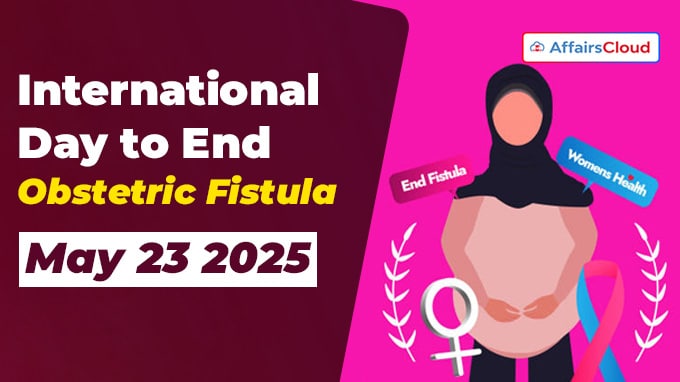
The United Nations (UN)’s International Day to End Obstetric Fistula is annually observed across the globe on 23rd May to raise awareness about obstetric fistula, a preventable and treatable childbirth injury affecting both mothers and their babies.
- The day aims to encourage action to stop, treat, and end obstetric fistula, and to gather support for the many women and girls, mainly in poor areas
Theme:
The theme of International Day to End Obstetric Fistula 2025 is “Her Health, Her Right: Shaping a Future Without Fistula”, emphasises the urgent need to uphold every woman’s sexual and reproductive health rights and eliminate this preventable condition by 2030.
Background:
i.The International Day to End Obstetric Fistula was established by the United Nations General Assembly (UNGA) through resolution A/RES/67/147, adopted on 20 December 2012.
ii.The resolution highlighted the main causes include poverty, malnutrition, limited access to healthcare, early childbirth, child marriage, violence against girls, and gender inequality, stressing that poverty is the biggest risk factor.
iii.The first International Day to End Obstetric Fistula was observed on 23rd May 2013.
About Obstetric Fistula:
i.Obstetric Fistula is a severe childbirth-related injury caused by prolonged, obstructed labour without timely and adequate medical intervention.
ii.It leads to the formation of a hole (fistula) between the birth canal and the bladder and/or rectum, resulting in chronic incontinence of urine or faeces.
iii.This condition often results in Severe physical and psychological trauma, Social stigma and isolation and Chronic health issues and infertility.
Prevention and Treatment:
Requires access to skilled birth attendants, emergency obstetric care, and family planning.
Global Initiatives:
i.The New York City (United States of America, USA) based United Nations Population Fund (UNFPA)’s ‘Campaign to End Fistula’, operating across 55 countries since 2003, focuses on prevention, treatment, and social reintegration, and has supported 150,000 surgical repairs.
ii.The London (United Kingdom, UK) based International Federation of Gynecology and Obstetrics (FIGO) Fistula Surgery Training Initiative trains surgeons in regions affected by obstetric fistula to help close the treatment gap.
iii.The Sustainable Development Goals (SDGs) aim to eliminate obstetric fistula by 2030 by improving and strengthening healthcare systems.
iv.In 2018, the United Nations General Assembly(UNGA) passed a resolution aiming to eliminate obstetric fistula by the year 2030.
Key Facts:
i.In 90% of obstetric fistula cases, the baby does not survive.
ii.Over 50,000 to 100,000 new cases develop globally each year.
iii.In the last 20 years, UNFPA has helped carry out 140,000 surgeries to repair obstetric fistula.
iv.From 2018 to 2023, over 12,000 women and girls were supported with services to help them return to normal life and reintegrate into society.
v.An estimated 2 million women in sub-Saharan Africa, Asia, the Arab region, and Latin America are living with untreated obstetric fistula.
About United Nations Population Fund (UNFPA):
i.The United Nations Population Fund (UNFPA), established in 1969 and formerly known as the United Nations Fund for Population Activities, is a UN agency dedicated to improving reproductive and maternal health worldwide.
ii.In 1987, the agency was renamed the United Nations Population Fund, while retaining the abbreviation UNFPA.
Executive Director (ED)– Dr. Natalia Kanem
Headquarters– New York, United States of America (USA)




